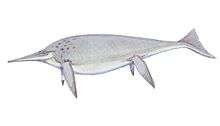Toretocnemus
Toretocnemus is an extinct genus of ichthyosaur. Its remains have been found in California, United States,[2] in Triassic layers of the Carnian Hosselkus Limestone.
| Toretocnemus | |
|---|---|
| Scientific classification | |
| Kingdom: | Animalia |
| Phylum: | Chordata |
| Class: | Reptilia |
| Order: | †Ichthyosauria |
| Family: | †Toretocnemidae |
| Genus: | †Toretocnemus Merriam, 1903 |
| Species | |
| |
| Synonyms | |
| |
Toretocnemus was named in 1902 by John Campbell Merriam.[3] The generic name is derived from Greek toretos, "perforated" and kneme, "shinbone". The type species is Toretocnemus californicus. Its holotype is UCMP 8100, a skeleton lacking the skull. Merriamia zitteli (Merriam 1903) Boulenger 1904, previously Leptocherius zitteli,[4] was renamed Toretocnemus zitteli in 1999. Its holotype is UCMP 8099, a skull, lower jaws and front of the torso.
Toretocnemus is about two metres long.
In 2001, Toretocnemus vertebrae were found in Sonora, Mexico, near the mining town of El Antimonio. Although ichthyosaur vertebrae are quite commonly found here, most of these were shonisaurid or shastasaurid vertebrae. These ones were noticeable for being much smaller than the usual finds, and were identified as Toretocnemus. The vertebrae ranged in diameter from 13 to 28 mm, were all taller than they were wide, and amphicoelous. Neural spines were not present, but there were clear grooves for their articulation. The processes for rib articulation were small and well-separated, with two on each vertebra - a diapophysis and a parapophysis. This is diagnostic of Toretocnemus. [5]
The vertebrae being found here suggest an unconventional origin for the Antimonio Formation, which is that it was separated from the East Klamath Terrane rather than from similar formations in Nevada, as Toretocnemus has been found in the East Klamath Terrane but never in Nevada. This is at odds with the established theory. However, as Toretocnemus was a small ichthyosaur and probably not a very strong open-ocean swimmer, it could be that these were from a different population which were geographically isolated and speciating.[5]
See also
- List of ichthyosaurs
- Timeline of ichthyosaur research
References
- "†Toretocnemus Merriam 1903 (ichthyosaur)". Paleobiology Database. Fossilworks. Retrieved 11 August 2017.
- Nicholls, Elizabeth L.; Wei, Chen & Manabe, Makoto (2003). "New material of Qianichtyosaurus Li, 1999 (Reptilia, Ichthyosauria) from the Late Triassic of southern China, and implications for the distribution of Triassic ichthyosaurs". Journal of Vertebrate Paleontology. 22 (4): 759–765. doi:10.1671/0272-4634(2002)022[0759:NMOQLR]2.0.CO;2.
- Merriam, J.C., 1902, "Triassic Ichthyopterygia from California and Nevada", Bulletin of the Department of Geology of the University of California, 3 (4): 63–108
- Merriam, J.C., 1903, "New ichthyosaurs from the Upper Triassic of California", Bulletin of the Department of Geology of the University of California, 3 (12): 249–263
- Lucas, Spencer (2002-01-01). "Toretocnemus, a Late Triassic ichthyosaur from California, U.S.A. and Sonora, Mexico". New Mexico Museum of Natural History and Science Bulletin. 21: 275–278.

